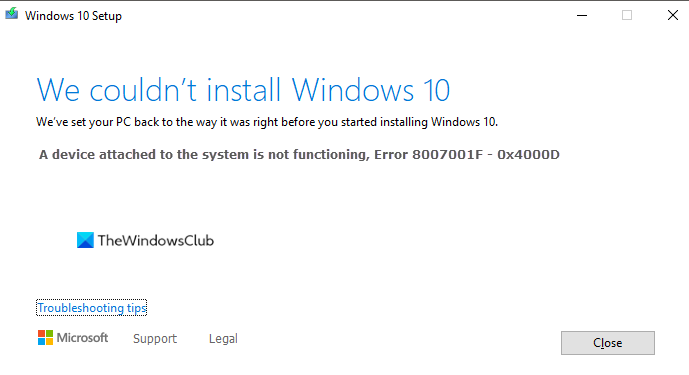The error codes 8007001F – 0x2000D, 8007001F – 0x3000D or 8007001F – 0x4000D are one of the numerous Windows upgrade errors PC users may encounter when attempting to upgrade to Windows 11 or update to the latest version/build of Windows 10 on their device. In this post, we will offer the most suitable solutions to this issue.

General failure, a device attached to the system is not functioning, Error code 8007001F – 0x4000D
Windows Upgrade error 8007001F – 0x4000D
If you’re faced with this issue, you can try our recommended solutions below in no particular order and see if that helps to resolve the Windows Upgrade error 8007001F – 0x4000D on your device.
- Run Windows Update Troubleshooter
- Run SFC and DISM scan
- Analyze log files
- Update device drivers
- Disconnect all USB devices
- Perform a Hardware Clean Boot
- Run SetupDiag
- Use Microsoft Virtual Support Agent
Let’s take a look at the description of the process involved concerning each of the listed solutions.
1] Run Windows Update Troubleshooter
In some case, Windows update errors can be resolved using the inbuilt Windows Update Troubleshooter. The automated wizard is designed to help resolve the problem if you get an error code while downloading and installing Windows updates on your Windows 11/10 computer. After you run the utility, you can try the upgrade operation again. If the procedure fails again, try the next solution.
2] Run SFC and DISM scan
If you have system files damaged or corrupted on your Windows PC, you may encounter the Windows Upgrade error 8007001F – 0x4000D.
You can run both the SFC scan and DISM scan in tandem using the procedure below.
- Press Windows key + R to invoke the Run dialog.
- In the Run dialog box, type notepad and hit Enter to open Notepad.
- Copy and paste the syntax below into the text editor.
echo off date /t & time /t echo Dism /Online /Cleanup-Image /StartComponentCleanup Dism /Online /Cleanup-Image /StartComponentCleanup echo ... date /t & time /t echo Dism /Online /Cleanup-Image /RestoreHealth Dism /Online /Cleanup-Image /RestoreHealth echo ... date /t & time /t echo SFC /scannow SFC /scannow date /t & time /t pause
- Save the file with a name and append the .bat file extension – eg; SFC_DISM_scan.bat and on the Save as type box select All Files.
- Repeatedly run the batch file with admin privilege (right-click the saved file and select Run as Administrator from the context menu) until it reports no errors.
- Restart your PC.
On boot, try the upgrade again. If unsuccessful, proceed with the next solution.
3] Analyze log files
This solution requires you to analyze Windows Setup log files on your computer in order to determine the device that is not functioning properly. Once you identify the faulty device, you can either disconnect, update, or replace the device.
4] Update device drivers
As the error description indicates a general failure due to a device attached to the system is not functioning, it’s likely that the device drivers is outdated, corrupted or damaged; assuming the device itself is not damaged or faulty. In this case, as you have identified the faulty device from the log files, make sure to update your drivers manually via the Device Manager, or you can get the driver updates on the Optional Updates section under Windows Update. You may also download the latest version of the driver for the device from the manufacturer’s website.
If all drivers are up to date but the error persists, you can try the next solution.
5] Disconnect all USB devices
Disconnect all USB devices from your computer and then try the upgrade and see if that helps.
6] Perform a Hardware Clean Boot
This solution requires you to perform a Hardware Clean Boot and then run the Windows 11/10 upgrade operation again and see if the procedure completes without errors. Otherwise, try the next solution.
7] Run SetupDiag
You can run SetupDiag – a diagnostic tool from Microsoft that PC users can use to obtain details about why a Windows 11/10 upgrade was unsuccessful.
8] Use Microsoft Virtual Support Agent
The Microsoft Virtual Support Agent is another viable route you can take to troubleshoot the error in hand.
Hope any of these solutions work for you!
Related post: Windows Upgrade Error Code 8007001F – 0x3000D
What to do if Windows Update keeps failing?
if Windows Update keeps failing on your Windows 11/10 device, you can try the following methods to fix the issue:
- Run the Windows Update Troubleshooter tool.
- Restart Windows Update-related services.
- Run the System File Checker (SFC) scan.
- Execute the DISM command.
- Temporarily disable your antivirus.
- Restore Windows 10 from a backup.
How do I fix error code 0x8007001F?
To fix the error code 0x8007001F in Windows 11/10 PC, you need to run the Windows Update Troubleshooter first. If it does nothing, you can use the System File Checker and DISM tools. Following that, you can update your device drivers, disconnect all USB devices, etc. Finally, you can also use the Microsoft Virtual Support Agent to get it fixed.
What is 0 * 8007001f?
Such errors occur due to drivers. Some people claimed that they had got this error after installing the audio driver. Although Windows 11 runs smoothly without installing an audio driver, some hardware requires you to install the driver. If you encounter such a problem, you can go through the aforementioned tips and tricks to get it fixed.
Leave a Reply